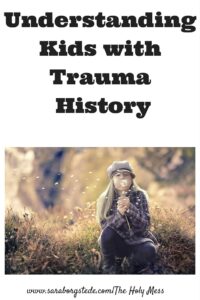
If you parent or work with kids today, especially kids with behavior needs of any type, there is important information about trauma that will dramatically impact the way you interact with children.**
Even though I’ve been working with kids who experienced childhood trauma for years, until a short time ago I didn’t put the pieces of the puzzle together. I saw the effects in my own children and children I’ve worked with, but I couldn’t exactly explain why, and I didn’t have the most effective tools for helping children change their behaviors.
This outside reading is well worth the effort. I’ve done a ton of reading about kids and trauma, and I won’t recommend something unless it’s really worth your time:
The Trauma Roadblock by Aaron Wiemeier (A fantastic putting-together-the-pieces overview of how trauma affects kids and us as adults.)
Lies and Truth in Christ:A Psychological Spin on the Gospel by Aaron Wiemeier (A similar article to above, from a Christian perspective.)
The Trauma Tree: Understanding the Impact of Childhood Trauma by steampoweredfamily.com
Although it’s true that I continue to run into people who think “kids are resilient and bounce back”, these days most of us who work with kids with behavior needs understand there are deeper issues going on. Work with these kids for a day and you understand that typical discipline or parenting methods aren’t going to cut it. Childhood trauma is real, and it’s tough.
When a baby or young child experiences trauma at a young age, from abuse, neglect, or witnessing domestic violence, changes happen in brain at a deep level. Just as critical, because children are self-focused, a child assigns negative meaning to himself or herself associated to the event. These are beliefs like, “I’m worthless.” or “I’m no good.” or “I’m a failure.”
Not all children who have behavioral needs have experienced early childhood trauma. However, there are also cultural issues at play.
It’s important to understand that most kids in our culture today — most of us — are experiencing trauma. Watched Walking Dead lately? CNN? Played video games? Seen a typical commercial or music video? Our children are exposed, over and over to high levels of violence, aggression, and highly sexualized content on a regular basis.
Mike and I are relatively strict about what our children play and watch. Our kids watch far less than most children their age, yet we’ve still noticed that our children are desensitized to violence in a way that’s scary to me. Shows that would — heck, still do — scare the socks off me, simply do not phase them. Imagine their peers who watch rated R moves at age 6 and play violent video games for hours every day. This is not healthy.
No one will for a second convince me this is good for their practice of fine motor skills for when they all become surgeons and pilots someday, either.
All of us, even from wonderful families, experience trauma at some point in our childhood and lives. This is part of living in a sinful world.
God has designed our brains with an amazing ability to heal (see Aaron’s articles above), and we continue to seek out that healing, but it involves work and becoming conscious of what we are doing.
For a child with a significant trauma history, a simple incident, such as a missing notebook or a comment from a friend, can trigger the internal negative thoughts he or she constantly has playing. Rather than deal with these incredibly painful feelings, the child acts out in a number of ways to avoid the feelings — rage, violence, aggression, compulsions, controlling and manipulative behaviors, or lying.
The key to healing is to take the mask off the behaviors and begin to deal with what is really going on underneath.
Also important for these children is physically healing parts of the brain that have been affected. This is where The Neurosequential Model by Dr. Bruce Perry becomes important. This method identifies specific areas of the brain that are damaged by childhood trauma. This may involve sensory therapy, music, animal therapy, massage, or other activities specifically targeted to areas of the brain in need of healing.
Healing from trauma is complex and requires commitment to treatment, but God has designed our brains with an amazing ability to do so. The first step is for the adults in the child’s world to have a correct understand of what is required for healing to happen.

**Note: For more specific help, seek the help of a professional therapist. This article from Web MD offers suggestions on how to find a therapist who is right for you, your child, or children you work with. If you live in the Denver area, you are welcome to email me at [email protected] for referrals.

Foster & Adoptive Parents

Do you parent a child who's experienced stress, trauma, or grief?
*Foster & adoptive parents, grandparents raising grandkids, if your child has experienced trauma or loss -- this resource is JUST FOR YOU!
*FREE Super-helpful printables! 8 resources you can print and use today.
*Receive helpful updates specifically for foster and adoptive parents.







Thanks for the resources Sara! I actually haven’t read any of those yet, and am always looking for material to help me better parent my kids.
Good read and great resources. Thank you for being open and honest about your journey, it is helping others.